Elite life

Mushrooms
Tricholoma
║ Mushrooms ║
Tricholoma albobrunneum
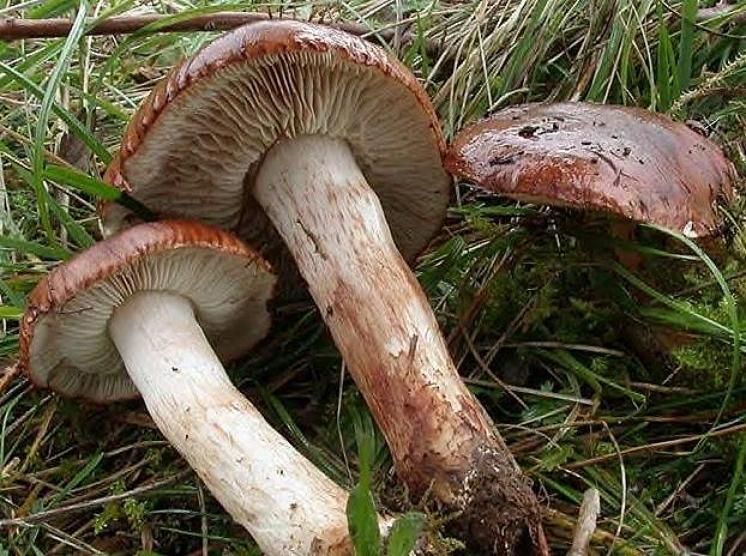
Cap 5-8 cm across, conico-convex, reddish-brown and covered in fine innate radiating fibrils, greasy or viscid. Stem 60-80 x 10-15 mm, whitish above the distinctive ring zone but reddish brown below remaining slightly scaly in the upper portion. Flesh white tinged brownish below the cap cuticle and towards the stem base. Smell faintly mealy. Gills white, reddish-brown with age. Spore print white. Spores broadly elliptical, 5 x 3-4 μm.
Colored Tricholoma (Tricholoma columbetta)
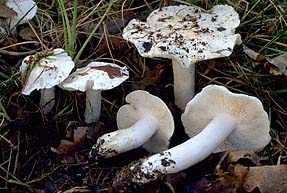
Cap 5-10 cm across, convex then expanding, silky white sometimes with greenish, pinkish or violet-blue spots when old. Stem 40-100 x 10-20 mm, rooting, white sometimes blue-green at base. Flesh white, firm. Taste none, smell not distinctive. Gills white, crowded. Spore print white. Spores oval, 5.5-7 x 3.5-5 μm.
Man on Horseback, Yellow Knight (Tricholoma equestre)

Cap: 3-12 cm; broadly convex or nearly flat; sticky when fresh, but often dry; bright yellow when young and fresh, often with an olive brown or brownish center; becoming yellow-brown by maturity; smooth or with a few appressed fibers over the center, (but not prominently overlaid with blackish radiating fibers); the margin initially rolled under somewhat.
Gills: Attached to the stem, often by means of a notch; close; pale to bright yellow.
Stem: 2-10 cm long; up to 2 cm thick; more or less equal, or with an enlarged base; smooth or very finely hairy; pale yellow or whitish near the apex, yellow below; often discoloring yellow-brown, especially near the base.
Flesh: White to very pale yellow near the cap surface; not changing on exposure.
Spore Print: White.
Birch Knight (Tricholoma fulvum)
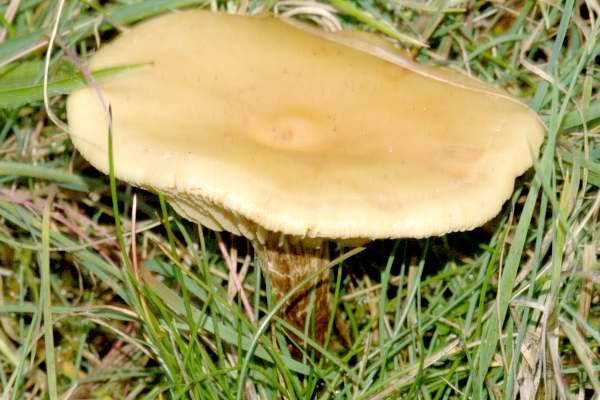
Cap 4-8 cm across, expanded convex with a slight umbo, brown to reddish-brown and finely streaky. Stem 30-70 x 8-14 mm, concolorous with the cap, fibrous. Flesh whitish in cap, yellow in stem. Taste mild, smell mealy. Gills yellowish becoming spotted brownish with age. Spore print white. Spores elliptical, 5-7 x 3-4.5 μm.
Calocybe Gambosa (Tricholoma gambosum)
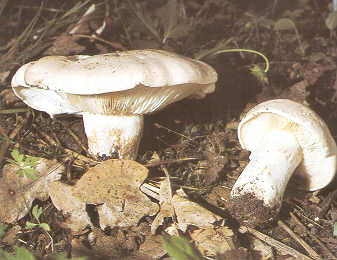
Cap 5-15 cm across, subglobose then expanding, often irregularly wavy and sometimes cracking, margin inrolled, white. Stem 20-40 x 10-25 mm, white. Flesh white, soft. Taste and smell mealy. Gills narrow, very crowded, whitish. Spore print white. Spores elliptical, 5-6 x 3-4 μm.
Matt Knight Cap (Tricholoma imbricatum)
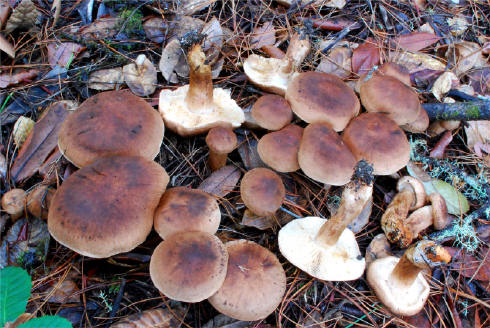
Pileus: Cap 6-15 cm broad, convex expanding to nearly plane in age, the margin at first inrolled, then decurved, often wavy at maturity; surface dry, fibrillose to finely scaled or cracked near the margin, dark-brown at the disc, shading to medium-brown at the margin; flesh white, thick, discoloring slowly brown when injured; odor and taste mild.
Lamellae: Gills close, adnexed to notched, moderately broad, cream to buff, pale drab brown in age, often mottled darker brown at maturity, especially the edges.
Stipe 5-10 cm long, 2-3.5 cm thick, stout, solid, equal, or tapering to a narrow, sometimes rooted base, surface dry, dull, cream-buff at the apex, developing brown stains below; veil absent.
Spores 5.5-7.0 x 4-5 μm, elliptical, smooth; spore print white.
Pine Mushroom, American Matsutake (Tricholoma magnivelare)
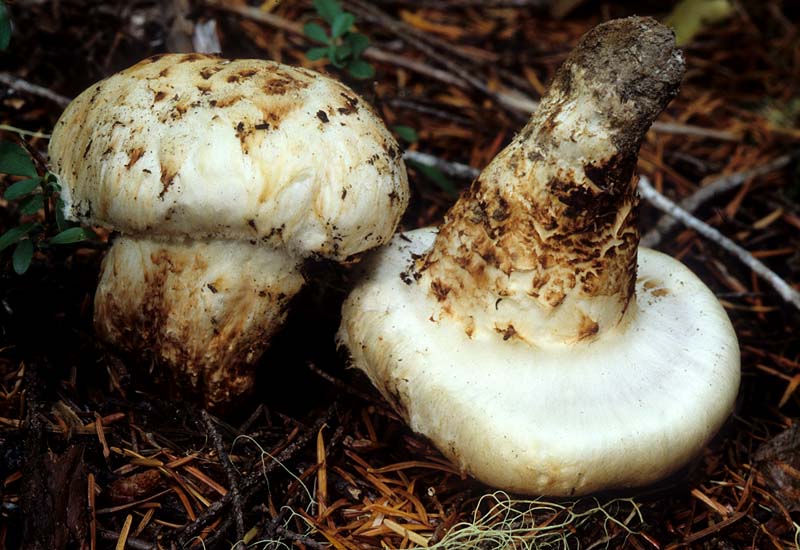
Cap: 5-20 cm; convex becoming broadly convex or nearly flat; dry or a little sticky; white at first; soon with brownish discolorations and pressed-down fibers; the margin rolled under when young.
Gills: Attached to the stem, sometimes by means of a notch; crowded; white, developing brown or reddish brown stains and spots with age.
Stem: 4-15 cm long; up to 5 cm thick; more or less equal, or with a slightly tapered base (but not with a long, rooting base); white above the ring, colored like the cap below; partial veil white and thick, collapsing to form a sheath around the lower stem and a prominent flaring ring at the top edge of the sheath.
Flesh: White; firm; not changing on exposure.
Spore Print: White.
Matsutake Mushrooms (Tricholoma nauseosum, Tricholoma matsutake)
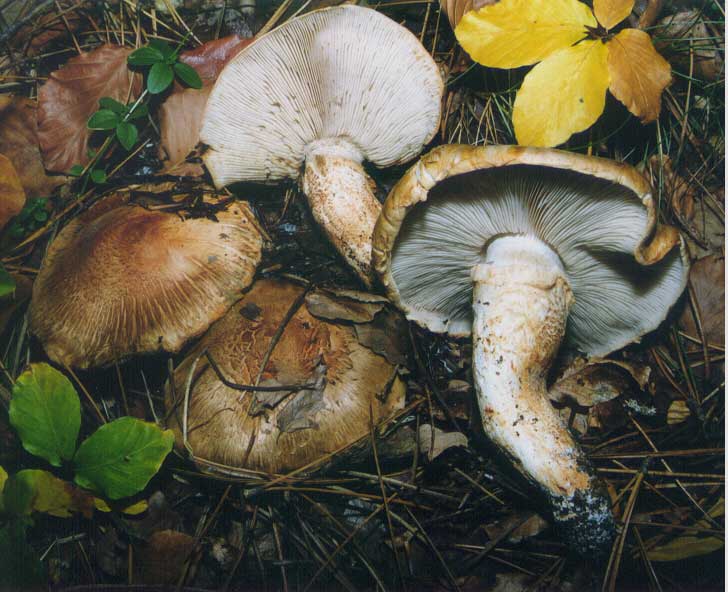
Tricholoma orirubens
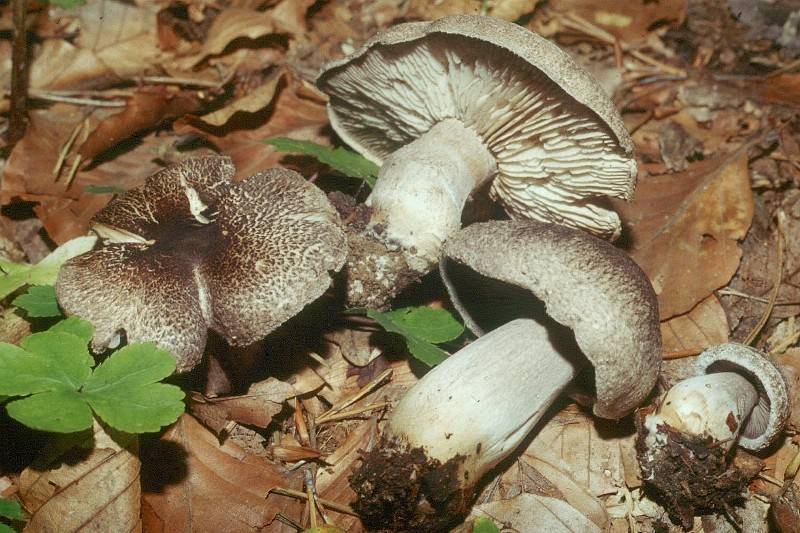
Cap 4-8 cm across, conical then expanded with an acute umbo, dark grey often paler at the margin, covered in black cottony or felty scales. Stem 40-80 x 10-15 mm, white becoming flecked with red often marked green or blue at the base, arising from pale sulphur yellow mycelium. Flesh white, eventually reddening. Taste not distinctive, smell strongly of meal. Gills white to greyish when young, then often turning pink and sometimes spotted. Spore print white. Spores broadly ovate to subglobose, 4-6.5 x 3-4.5 μm.
Tricholoma squarrulosum
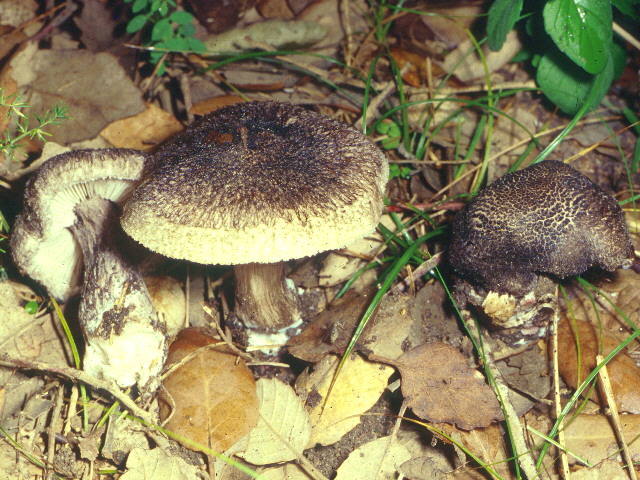
Cap 4-5 cm across, flattened convex, grey-brown, darker towards the centre, covered in blackish-brown scales. Stem 40-50 x 5-8 mm, greyish covered in fine blackish-brown scales. Flesh whitish to grey. Smell mealy. Gills whitish grey often slightly flesh-coloured. Spore print white. Spores pip-shaped, 7-8 x 4-5 μm.
║ Mushrooms ║